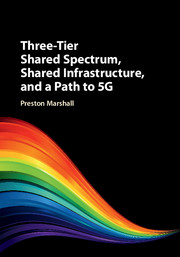Book contents
- Frontmatter
- Contents
- Acknowledgments
- Preface
- Part I Spectrum Sharing Background
- Part II Three-Tier Dynamic Spectrum Models
- Part III Components of a Three-Tier Architecture
- 5 Three-Tier Spectrum Admission Control Systems
- 6 Admission Control Management of Access Point Devices and Their Clients
- 7 Taxonomy of Protection Methods to Be Provided Across and Within Tiers
- Part IV Protection Processes for Incumbents and Peers
- Part V Example Use of Three-Tier Spectrum: Use of the 3.5 GHz CBRS Band in the USA
- Part VI Future Bands, Network Services, Business Models, and Technology
- Part VII Appendices
- Index
- References
7 - Taxonomy of Protection Methods to Be Provided Across and Within Tiers
from Part III - Components of a Three-Tier Architecture
Published online by Cambridge University Press: 30 August 2017
- Frontmatter
- Contents
- Acknowledgments
- Preface
- Part I Spectrum Sharing Background
- Part II Three-Tier Dynamic Spectrum Models
- Part III Components of a Three-Tier Architecture
- 5 Three-Tier Spectrum Admission Control Systems
- 6 Admission Control Management of Access Point Devices and Their Clients
- 7 Taxonomy of Protection Methods to Be Provided Across and Within Tiers
- Part IV Protection Processes for Incumbents and Peers
- Part V Example Use of Three-Tier Spectrum: Use of the 3.5 GHz CBRS Band in the USA
- Part VI Future Bands, Network Services, Business Models, and Technology
- Part VII Appendices
- Index
- References
Summary
Introduction to Three-Tier Analytic Components
This chapter focuses on the specific algorithmic components that may be included in protection modes that three-tier regimes may implement. It provides a set of basic methods that will later be integrated to address different types of incumbent or tiered user protection, and to provide coexistence between peer devices within a tier.
The topics of this chapter are dealt with in great detail by a number of works, and a very detailed description of any of these topics is beyond the scope of a single chapter. This chapter will instead focus on the unique aspects of the use of these approaches in three-tier spectrummanagement. The reader is referred to the section on further readings for more detailed background and more extensive and detailed science on the topics.
The use of an automated admission control system opens up opportunities for much more sophisticated methods to simultaneously improve interference avoidance and density of use. The decision system discussion is addressed separately from the protection discussion in order to isolate the purely technical aspects of the control system from the policy-driven protection criteria discussion. This chapter will focus on developing a basic set of analytic tools that are applicable to all spectrum management regimes, independent of their structure.
Challenges in Ecosystem Interference Protection
Our traditional approaches to interference protection have generally focused on extensive and detailed analysis of the worst case conditions between a small number of possibly interfering nodes, and a small number of victim nodes. The results of this analysis are then generalized to more complex deployments of both interfering and victim nodes. In a three-tier regime, it is desired to change this analytic process in many ways:
Ecosystem The interaction of all of the nodes in the ecosystem must be considered. The interactions of all nodes upon all other nodes must be considered, rather than extend one simple case.
Automated Analysis The analysis performed in the conventional processmay be based on science and physics, but the selection of cases and interpretation of results is a human process, and less scientific. For a three-tier system to operate effectively and flexibly, these decisions must be made automatically, and not be challengeable individually.
- Type
- Chapter
- Information
- Publisher: Cambridge University PressPrint publication year: 2017



